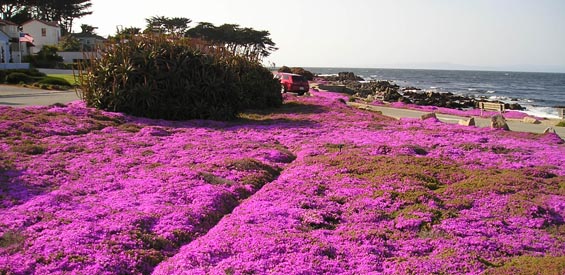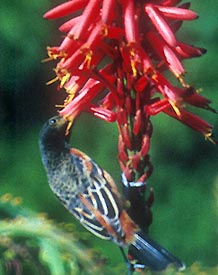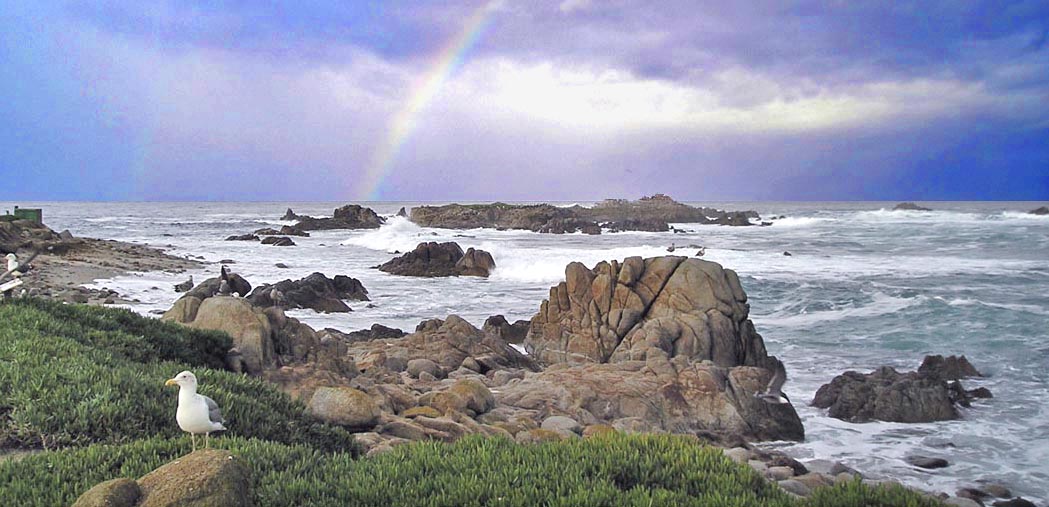 |
|||||||
Pt. Pinos is the northwestern tip of the Monterey Peninsula in Pacific Grove (above). It is world famous as a sea-watching site, but is also well known for the diversity of vagrants seen on Crespi Pond or in the adjacent cypresses. Unfortunately, most of the northwestern portion of Pacific Grove is a golf course so birding access is limited to the shoreline or the cypresses next to the restroom at Crespi Pond. Yet the public has access to the entire shoreline, so viewing rocky shorebirds and gulls is usually easy, and one can sea-watch from extensive public pull-outs along this entire stretch of coast. For a further discussion of seawatching at Pt. Pinos, see the text and photos on the Monterey Audubon Seawatch conducted dawn-to-dusk for six weeks by Tony Leukering and volunteers from 1 Nov to 15 Dec 2015 [that discussion is the major portion of the seasonal highlights there]. Monterey Audubon continues to sponsor formal seawatches here each autumn. eBirding the Pt. Pinos area: The map below shows the boundaries of the major eBird Hot Spot — Pt. Pinos-general — and its 'sub-locations' called Pt. Pinos--seawatch only and Pt. Pinos--south gull roost only. Most visitors will wish to use just the major Hot Spot [Pt. Pinos general area]. You can search the shore, check Crespi Pond, and conduct a seawatch all within the same checklist. Stay off the golf course. The 'sub-locations' are embedded within the Pt. Pinos-general Hot Spot. What makes them different than normal Hot Spots is that these 'sub-locations' are meant to be used only as stationary counts. Please use the "general" Pt. Pinos Hot Spot unless you want to do a stationary sea-watch or a stationary county of the gull roost. |
|||||||
 |
|||||||
The Pt. Pinos-general Hot Spot includes these interesting locations:
The Pt. Pinos 'sub-locations' — meant to be used for stationary counts — have these parameters:
The map above also shows the other "stand alone" Hot Spots in this part of Pacific Grove. These Hot Spots are separate and apart from Pt. Pinos, and birds present in any of these sites should not be included in the Pt. Pinos Hot Spots. Please use the boundaries shown on the map to enter eBird checklists for these areas. Two of them are along the shore:
The two other Hot Spots on the map above are inland areas and are not intended to be used for birds along the shore or at sea. You should count any seabirds flying over any of these Hot Spots — a few gulls, a wayward loon or pelican or cormorant (almost invariably a Double-crested if even a block inland) — but mostly these Hot Spots are good for landbirds, and especially migrant landbirds in spring or fall:
|
|||||||
 |
|||||||
In the 20th century, and before eBird, local birders designated a "Pt. Pinos Listing Area" — a somewhat larger area than an eBird "Hot Spot," and this is shown on the map below. There are now past of 8 eBird "Hot Spots" within the old "listing area." Some of us use all 10 of them to define a "Pt. Pinos Patch" in eBird lingo.
You can access an ever-changing list of species and a bar graph of their occurrence for each of the Hot Spots shown via eBird. Many local birders are working to improve the bar graphs by entering eBird data for every week of the year. About 340 species have been recorded within the Pt. Pinos "patch" and over 335 have been seen within the Pt. Pinos–general Hot Spot alone! These are truly remarkable numbers given the small size (~0.4 sq mi or 1.08 sq km) of the area. Few sites in North America this small can match this diversity. |
|||||||
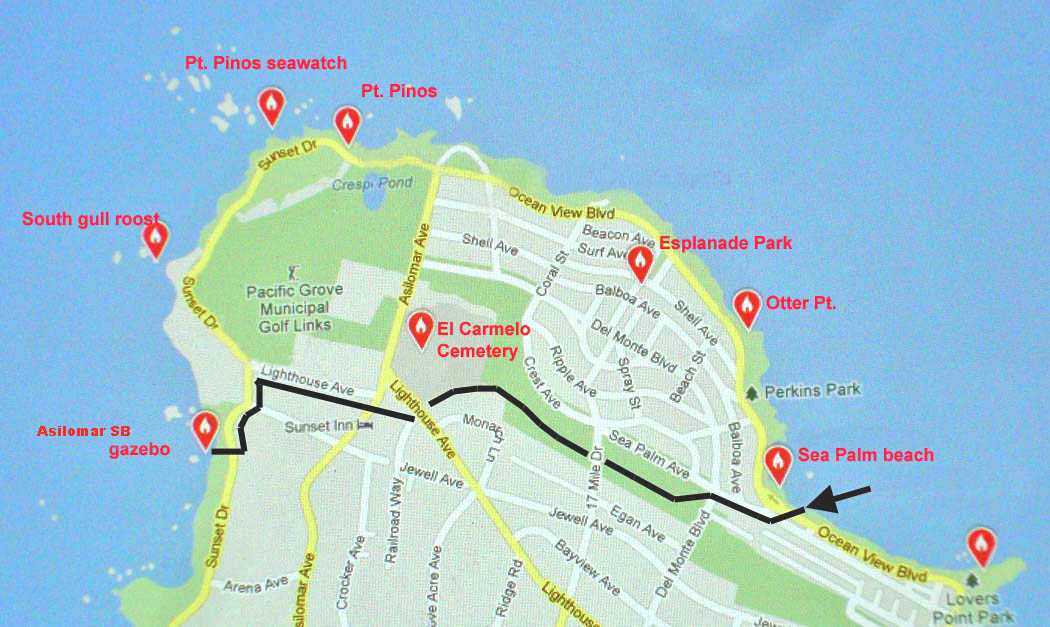 |
|||||||
Seawatching can be good at any season. The entire shoreline around Pt. Pinos is open to the public via large pull-outs on the Bay or Ocean side of the Point; there are benches or one can easily stand with a scope (or sit in a vehicle with a scope) to scan the sea. The sun is in your eyes looking west in the afternoon, but it is often better at any time to scan north from the Point, watching for birds flying out of the Bay westward towards the open ocean. The wind tends to pick up in the afternoon, and wind generally means better seawatching. Black-footed Albatross are almost routine on windy afternoons in the summer. The far rocks at the Point often have 3 species of cormorant (dominated by Brandt's) and loads of Brown Pelicans in season (summer, fall); an occasional booby has landed here. Huge waves batter these rocks (below). The strong winds usually come from the northwest. It is when these winds are howling at gale force — and waves completely engulf the rocks (inset below) that seawatching can be superb, as huge numbers of seabirds are blown into Monterey Bay and try to escape by flying west — into the winds — and past the Point. I remain in my car and scope out the window in those conditions; when it is too rough I may chose a spot several pull-outs east of the bare Point itself. Pelagics recorded in these conditions here include Cook's, Hawaiian & Mottled Petrels; nearly every shearwater or storm-petrel recorded from the county; all 3 jaegers and skua; nearly every west coast alcid, and five species of booby! |
|||||||
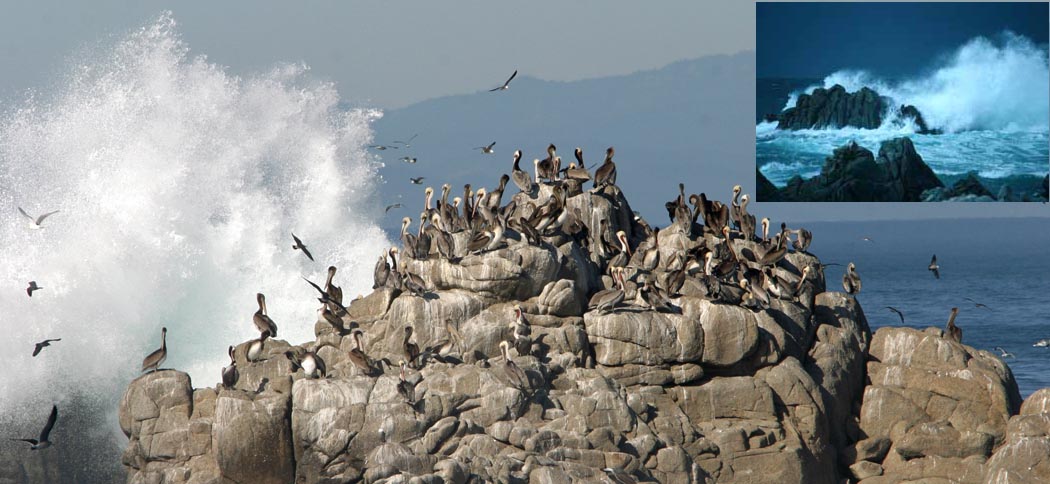 |
|||||||
In winter (Oct-Apr) oystercatchers are joined by flocks of Black Turnstone, Surfbird, Whimbrel, Willet, Sanderling, Black-bellied Plover, and occasionally Pacific Golden-Plover. Ruff and Rock Sandpiper have wintered twice. Wandering Tattler and Ruddy Turnstone are a spring and fall migrants. The tides make a difference for seeing rocky shorebirds. At high tides there are just a few flocks huddled together on offshore islets. At low tide, rocky shorebirds spread out to forage widely among the edges of tidepools or the ocean-rock interface. |
|||||||
 |
|||||||
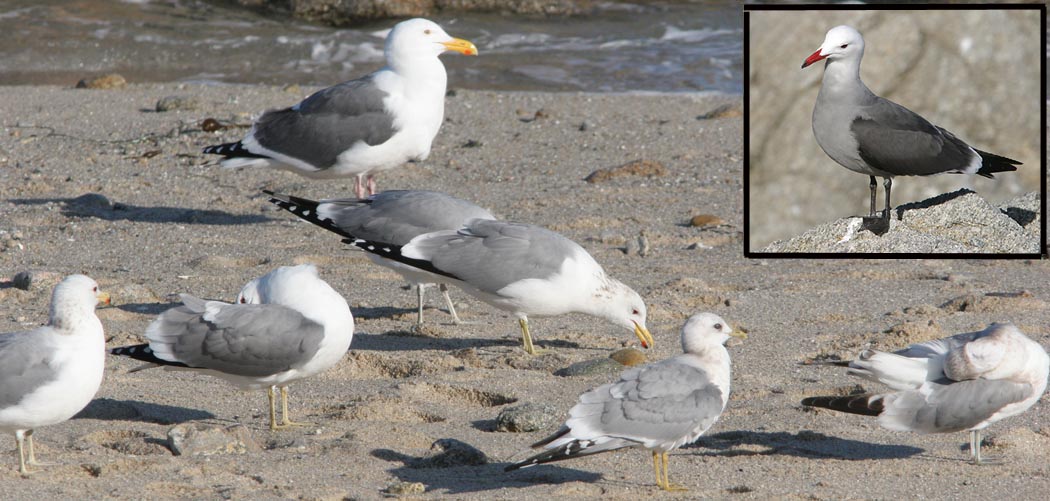 |
|||||||
|
|||||||
| While seawatching, seabirds, shorebirds, and gulls are a major part of birding at Pt. Pinos, it is also an exceptional location for migrant landbirds and waterfowl. This view (below) of Pt. Pinos from a boat just offshore shows the rocky shore; the parking areas used by tourists, and beyond them the Pacific Grove golf course and then the Monterey Pine forest of Pacific Grove, shrouded in typical summer fog, in the background. The Pt. Pinos Lighthouse is dead center. In front and to the right of the lighthouse are some of the Monterey Cypress trees that attract migrant landbirds near the public restrooms (the small brown building just right of the white pick-up truck). [Crespi Pond is out of view to the left of the white pick-up.] | |||||||
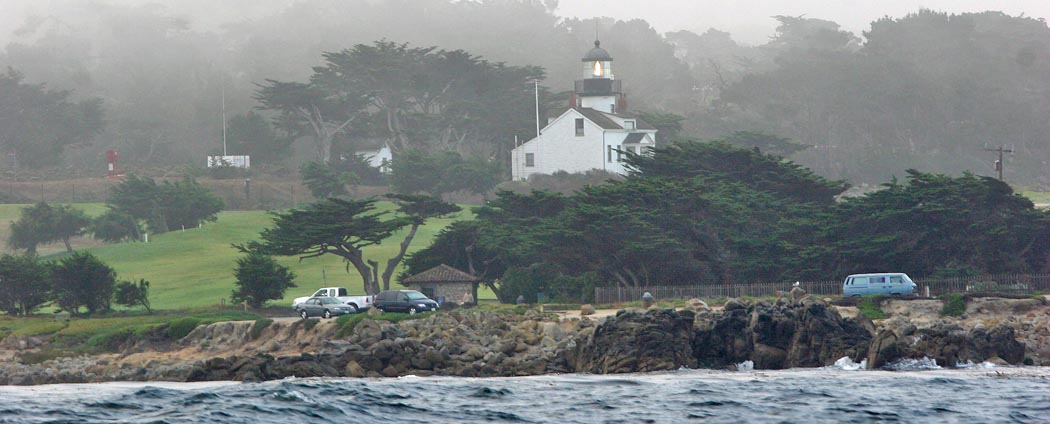 |
|||||||
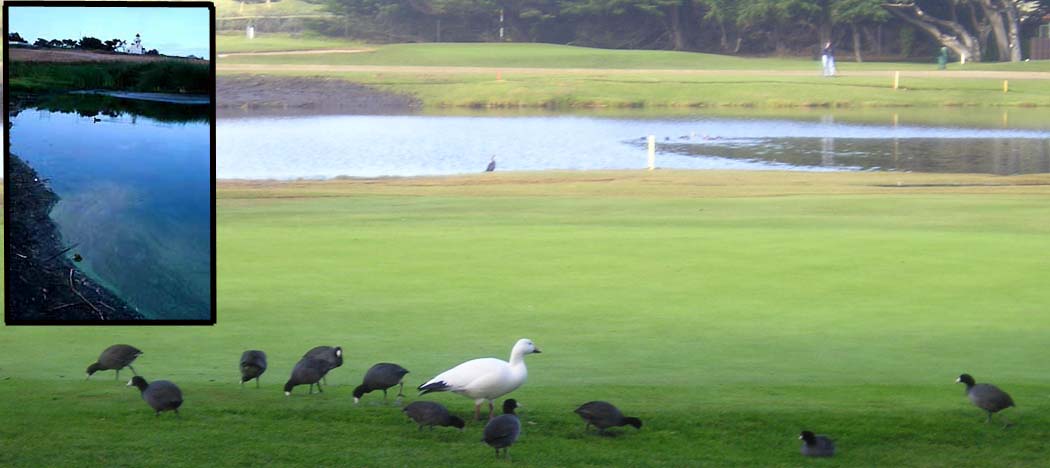 |
|||||||
| Crespi Pond (above) is a small natural pond, adjacent to the coast, named for Friar Juan Crespí who co-founded the Carmel Mission for Spain in 1770 with Father Juniperó Serra. Today Crespi Pond is used as a water hazard between the 17th tee and green on the Pacific Grove golf course. The inset photo (above) is from Oceanview Blvd, which separates Crespi from the shore, and shows the P.G. Lighthouse in the back of the reedbeds at the back side of Crespi. [The lighthouse, operating since 1855, is the oldest continuously operating lighthouse on the West Coast.] The photo above shows a Ross's Goose among the coots that winter at Crespi Pond. Canada Geese (from an introduced population) are resident here and breed, but migrant geese — Ross's, Snow, Greater White-fronted, Cackling, Brant — appear in small numbers during winter or migration. The pond has attracted a wide variety of waterfowl over the years, and even migrant waders when the pond level is low enough to have mudflat. "Bicolored" Red-winged Blackbirds often nest in the Crespi reedbed, which is also used as a day roost for Black-crowned Night-Herons. Watch for swallows over the pond in summer, and bathing gulls in winter. The Pacific Grove golf course is off-limit to the public when golfers are playing, so birders must view from the edge of Oceanview Blvd., or get here before 8 a.m. in the morning. A pebbly beach directly across from Crespi often has roosting gulls, or rocky shorebirds, and sometimes vagrant landbirds (e.g., Mountain Bluebird, Eastern Yellow Wagtail, and Snow Bunting have all occurred there). | |||||||
Unfortunately, access to key areas has diminished over recent decades, as a driving range was built and is now heavily used next to the Crespi reedbeds. It was once fairly easy to bird here (e.g., 1970s) but today birders' access to the back side of Crespi is essentially only very early or very late in the day, when no golfers are present. Since there are almost always golfers playing or using the driving range, birding is now generally limited to the cypresses in the immediate vicinity of the public restroom (FYI, the restroom is locked at night so may not be available for use very early and very late). Pacific Grove has a fenced water treatment area between the restrooms and the Point which is also off limits except to a few local birders with permission. |
|||||||
|
|||||||
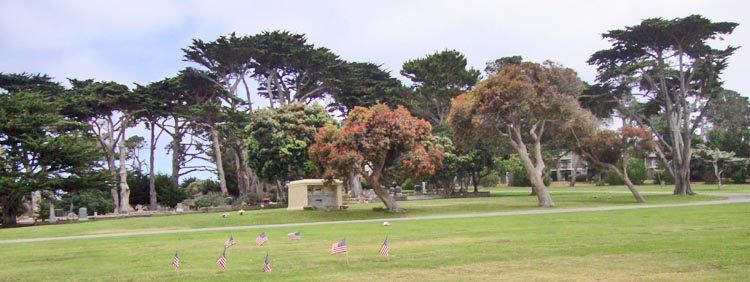 There is also good habitat for landbird migrants at the El Carmelo cemetery,
at the corner of Lighthouse & Asilomar, and adjacent to the public
golfcourse clubhouse. The cemetery is open to the public and landscaped
long ago with pines, cypresses, planted Myioporum bushes, and
red-flowering 'flame trees' in the summer/early fall (center of photo,
right). These 'flame trees' attract hummingbirds in Aug-Sep. In the NE
corner of the cemetery is a spot called "the thicket" — a topic of much
public debate when it was trimmed to make room for more grave sites.
Locals were concerned about a refuge and fawning area for the
ubiquitous Black-tailed Deer that are a constant part of the landscape
of this cemetery, and basically forced the City of Pacific Grove to
replant much of "the thicket" with native plants. The small area is a
nice spot to check in migration these days, as is the row of Myioporum
that separates this part of the cemetery from the golf course. Visitors
are reminded to stay off the golf course and limit their wanderings to
the cemetery grounds. There is also good habitat for landbird migrants at the El Carmelo cemetery,
at the corner of Lighthouse & Asilomar, and adjacent to the public
golfcourse clubhouse. The cemetery is open to the public and landscaped
long ago with pines, cypresses, planted Myioporum bushes, and
red-flowering 'flame trees' in the summer/early fall (center of photo,
right). These 'flame trees' attract hummingbirds in Aug-Sep. In the NE
corner of the cemetery is a spot called "the thicket" — a topic of much
public debate when it was trimmed to make room for more grave sites.
Locals were concerned about a refuge and fawning area for the
ubiquitous Black-tailed Deer that are a constant part of the landscape
of this cemetery, and basically forced the City of Pacific Grove to
replant much of "the thicket" with native plants. The small area is a
nice spot to check in migration these days, as is the row of Myioporum
that separates this part of the cemetery from the golf course. Visitors
are reminded to stay off the golf course and limit their wanderings to
the cemetery grounds. |
|||||||
|
page created 17 June- 11 July 2012, updated 8 Nov 2018 |
all photos & text © Don Roberson |
back to HOME |
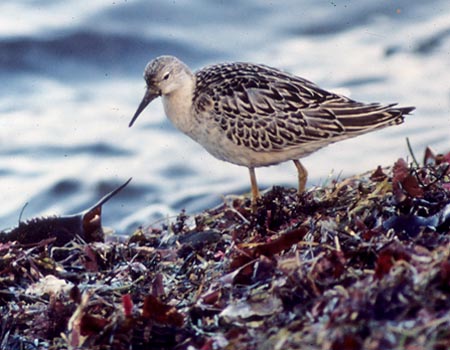 This
listing area — or "patch" —was defined about 1980 to include the ~260
acres of the entire Point, "from Ruff to Ruff outside the RR track." In
the 1970s, a Ruff wintered in successive winters at Sea Palm beach
(foot of Sea Palm Ave; photo right from 7 Nov 1976 © Ron Branson)
and on kelp below the gazebo at Rocky Shores. These spots provide nice
"bookends" to the coastal crescent — about a 2 mile walk between the
spots on Ocean View Blvd. and Sunset Drive. The old "railroad tracks"
are gone but are now replaced by a public hiking trail from Railroad
Way & Lighthouse Ave., through the middle of the eastern reaches of
the golf course (where obscure) and then picks up again at the foot of
Lovers Pt., just outside the listing area.
This
listing area — or "patch" —was defined about 1980 to include the ~260
acres of the entire Point, "from Ruff to Ruff outside the RR track." In
the 1970s, a Ruff wintered in successive winters at Sea Palm beach
(foot of Sea Palm Ave; photo right from 7 Nov 1976 © Ron Branson)
and on kelp below the gazebo at Rocky Shores. These spots provide nice
"bookends" to the coastal crescent — about a 2 mile walk between the
spots on Ocean View Blvd. and Sunset Drive. The old "railroad tracks"
are gone but are now replaced by a public hiking trail from Railroad
Way & Lighthouse Ave., through the middle of the eastern reaches of
the golf course (where obscure) and then picks up again at the foot of
Lovers Pt., just outside the listing area. 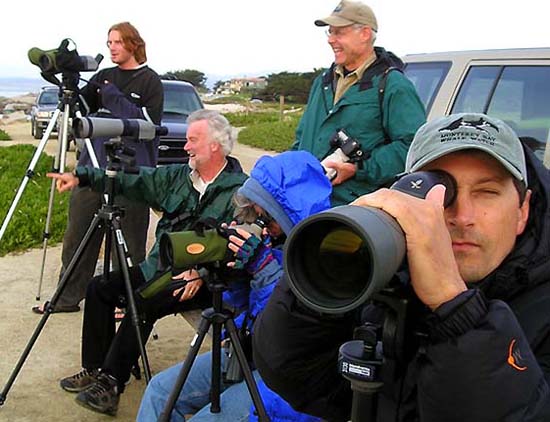 Birding at Pt. Pinos
Birding at Pt. Pinos Rocky shorebirds
are a key group here, with good habitat throughout the area, but
especially on the ocean side. Black Oystercatcher (left, with precocial
young) are resident and breed on the small rocky islets. [Incidentally,
these rocky islets are part of California Coastal National Monument,
established on Jan. 11, 2000.] New signs went up in 2012 to protect
regular nesting sites (below).
Rocky shorebirds
are a key group here, with good habitat throughout the area, but
especially on the ocean side. Black Oystercatcher (left, with precocial
young) are resident and breed on the small rocky islets. [Incidentally,
these rocky islets are part of California Coastal National Monument,
established on Jan. 11, 2000.] New signs went up in 2012 to protect
regular nesting sites (below). 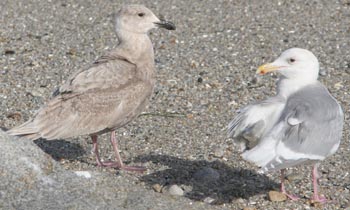
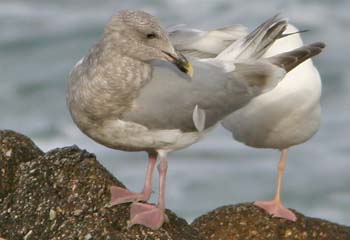
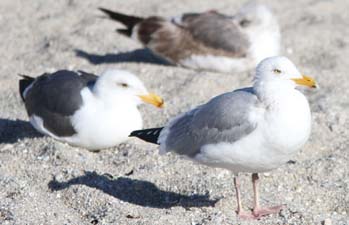
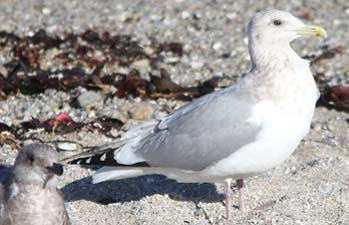
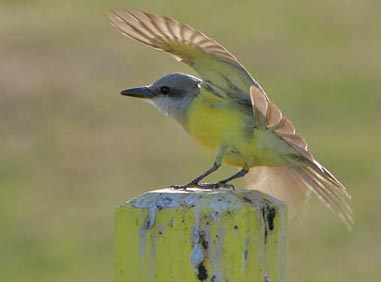 An
incredible plethora of migrant landbirds have occurred in the cypress
and pine trees adjacent to Crespi Pond, primarily in Sep-Nov, but also
May-early June. Tropical Kingbird (right) is a
vagrant but is found at Pt. Pinos in Oct/Nov of most years, and some
(like this one photo'd in Jan 2010) have wintered here. At least 18
species of eastern warblers have occurred in the trees; the Crespi
reeds have hosted Least Bittern, Bobolink, and Swamp Sparrow, among
other rarities. [A link to the "top 10" vagrants at Pt. Pinos is below.]
An
incredible plethora of migrant landbirds have occurred in the cypress
and pine trees adjacent to Crespi Pond, primarily in Sep-Nov, but also
May-early June. Tropical Kingbird (right) is a
vagrant but is found at Pt. Pinos in Oct/Nov of most years, and some
(like this one photo'd in Jan 2010) have wintered here. At least 18
species of eastern warblers have occurred in the trees; the Crespi
reeds have hosted Least Bittern, Bobolink, and Swamp Sparrow, among
other rarities. [A link to the "top 10" vagrants at Pt. Pinos is below.]